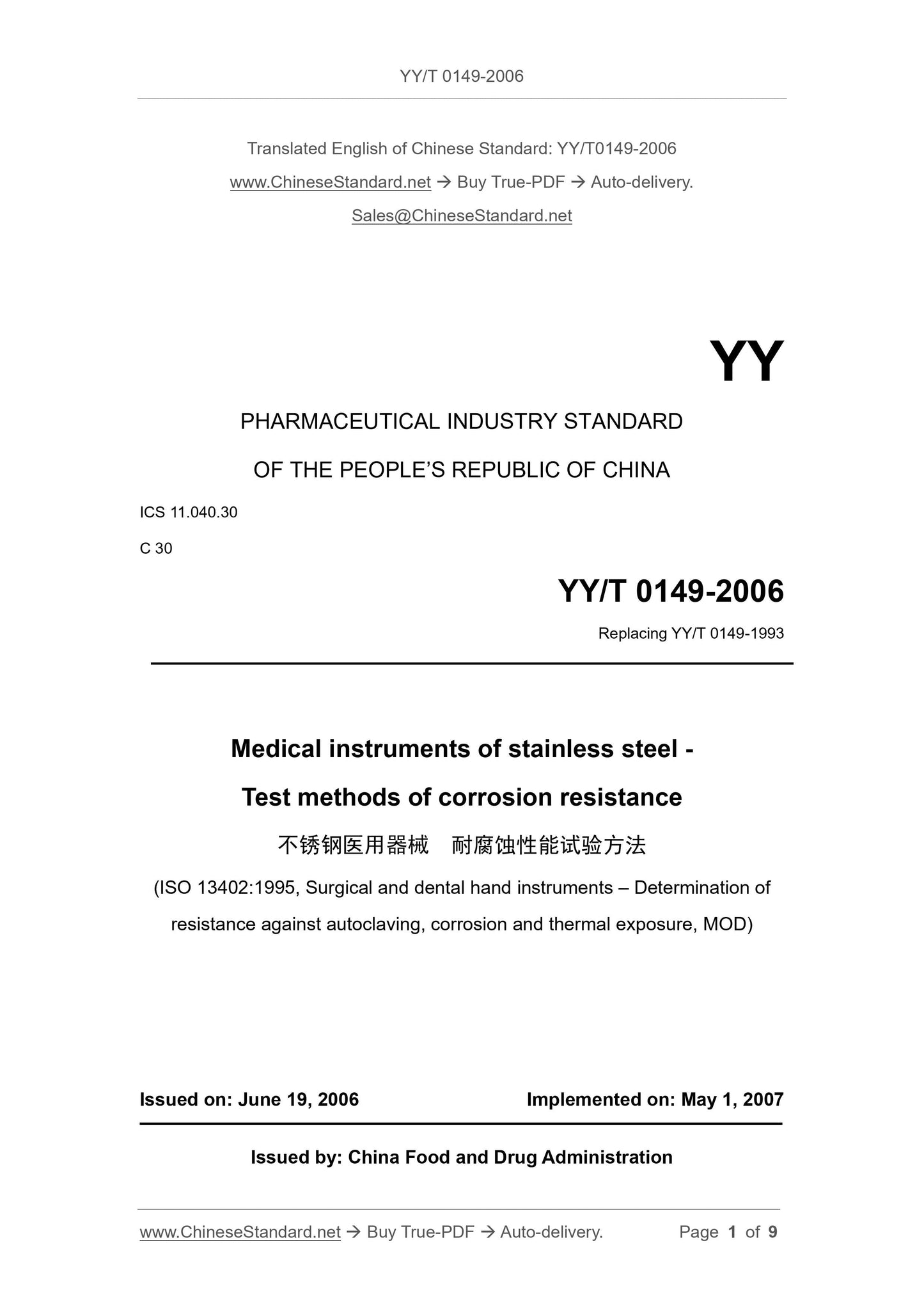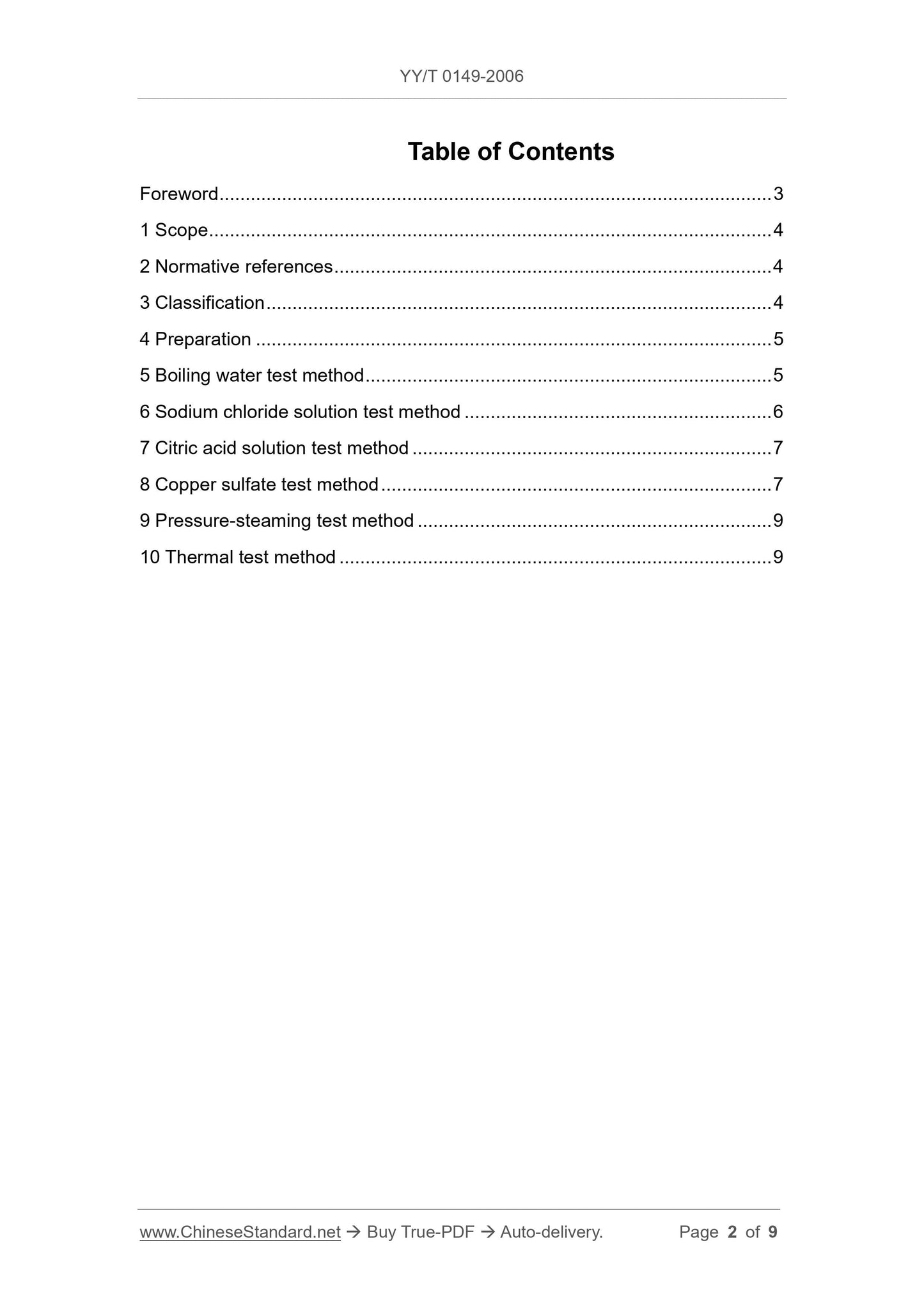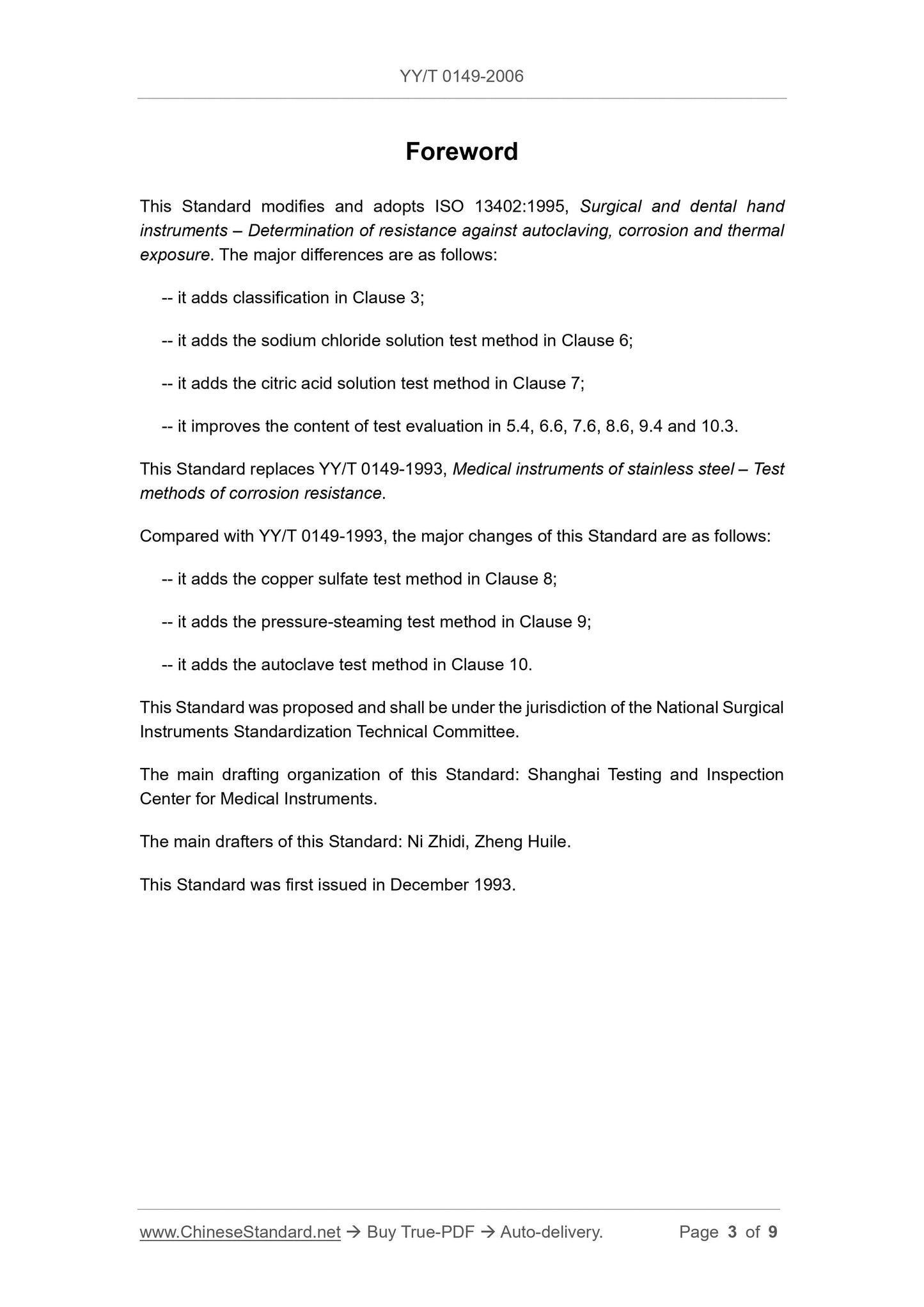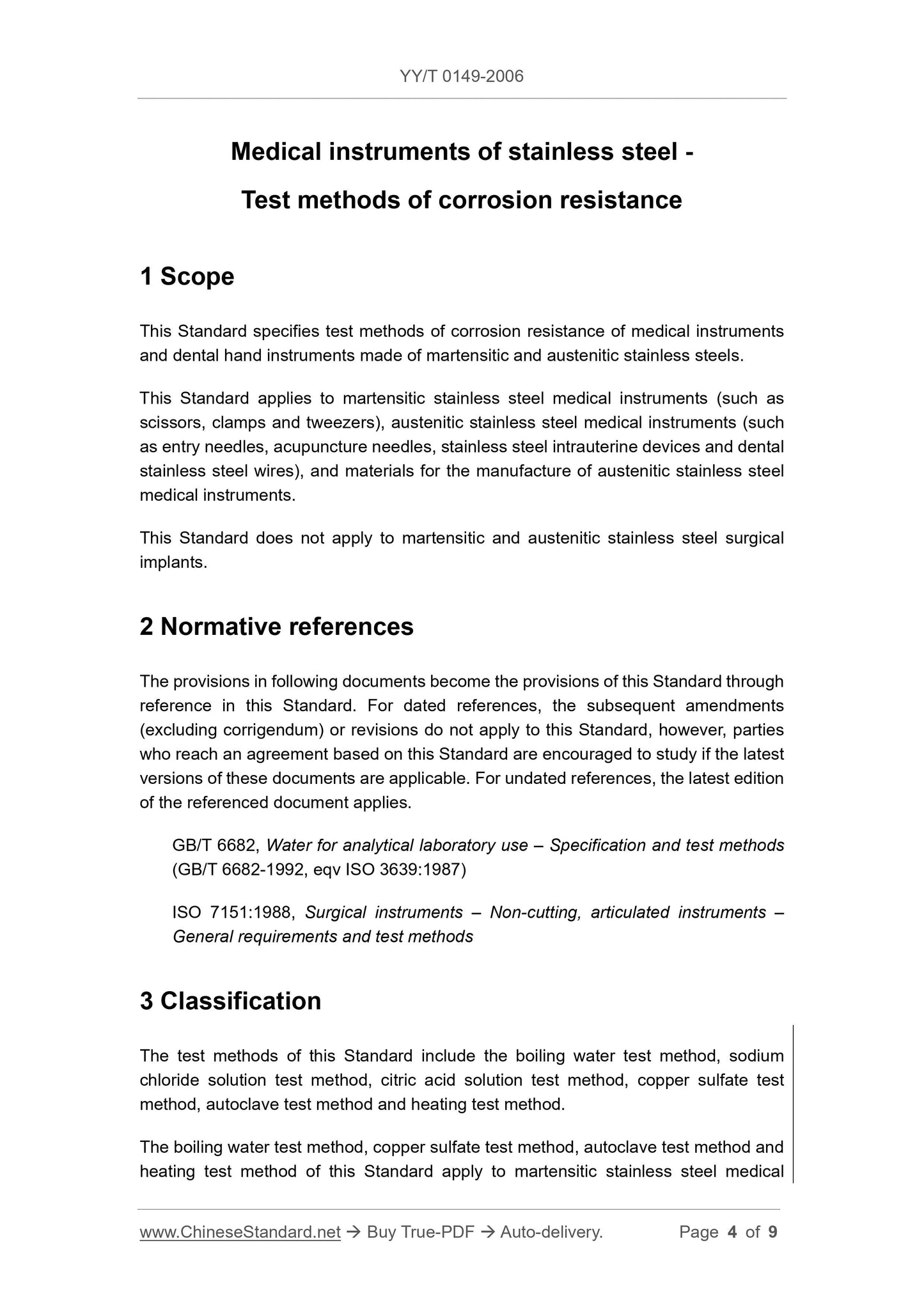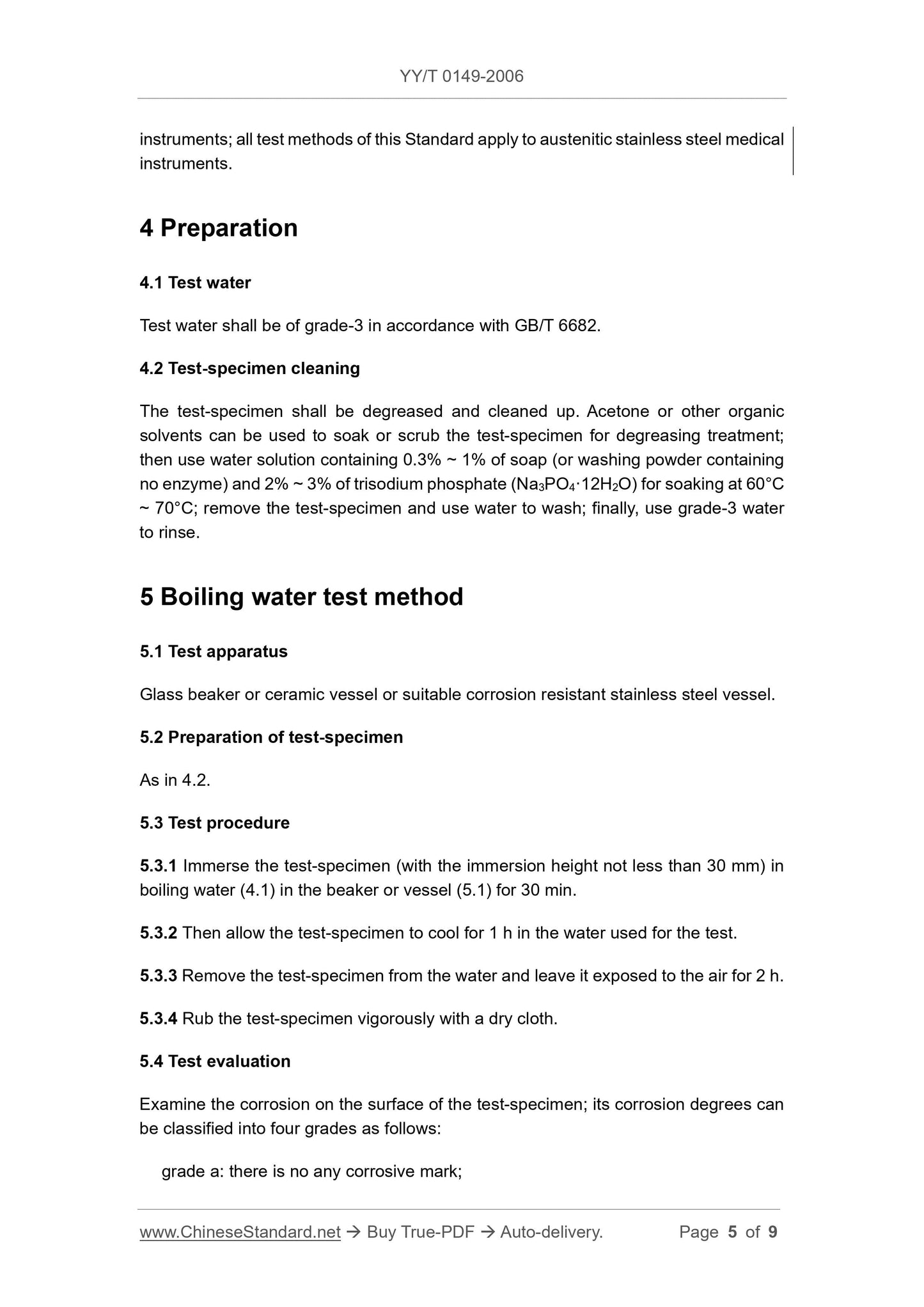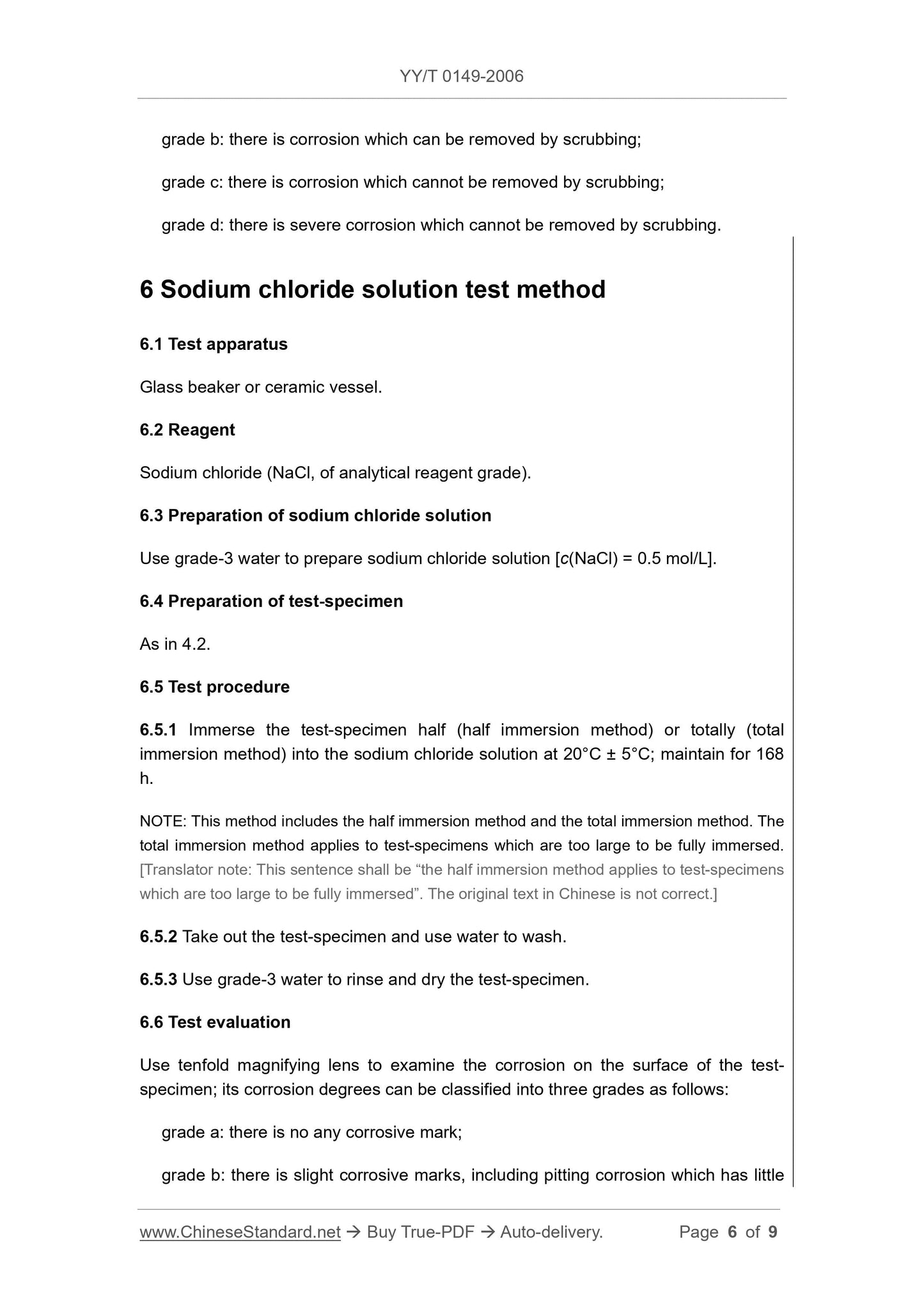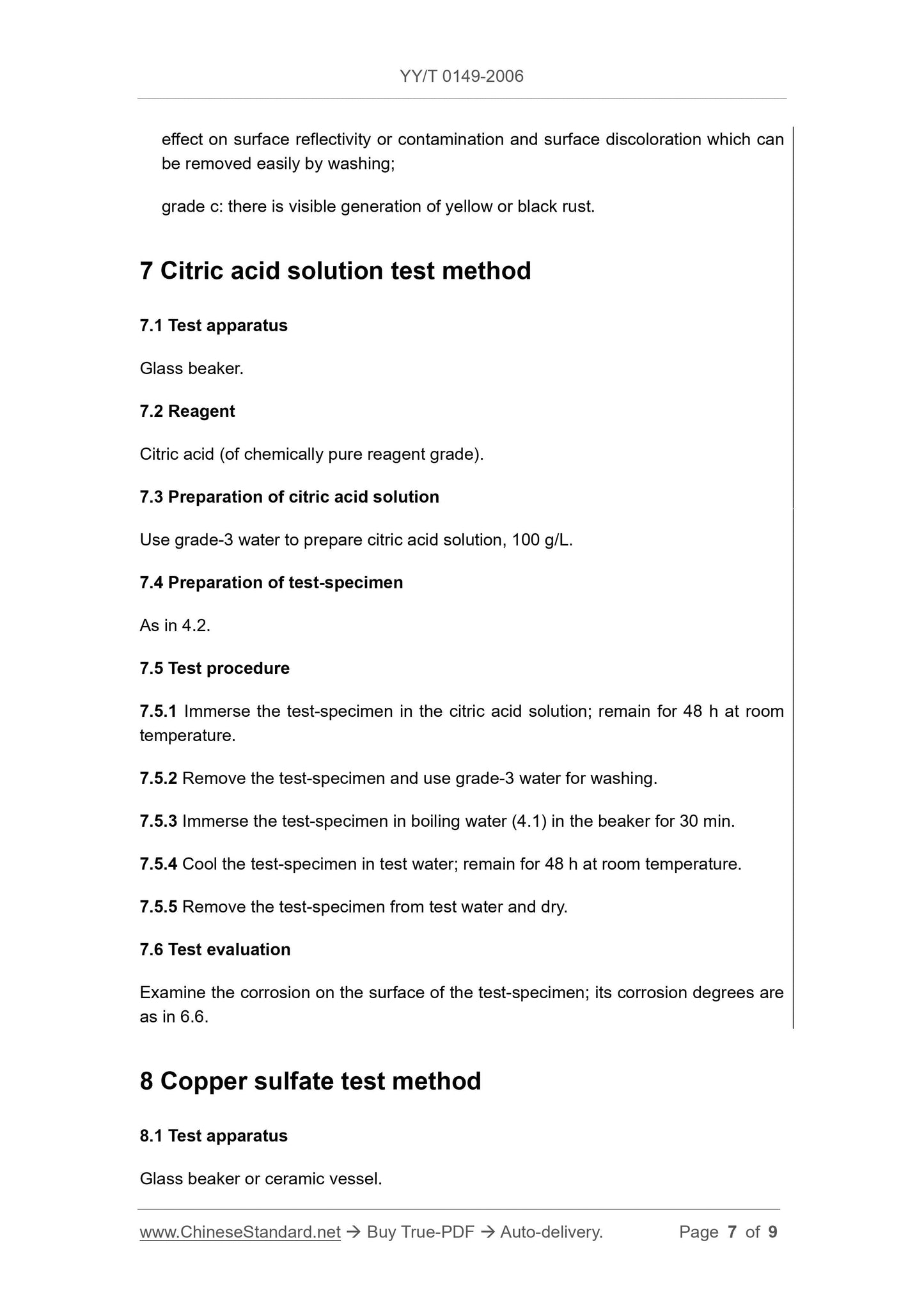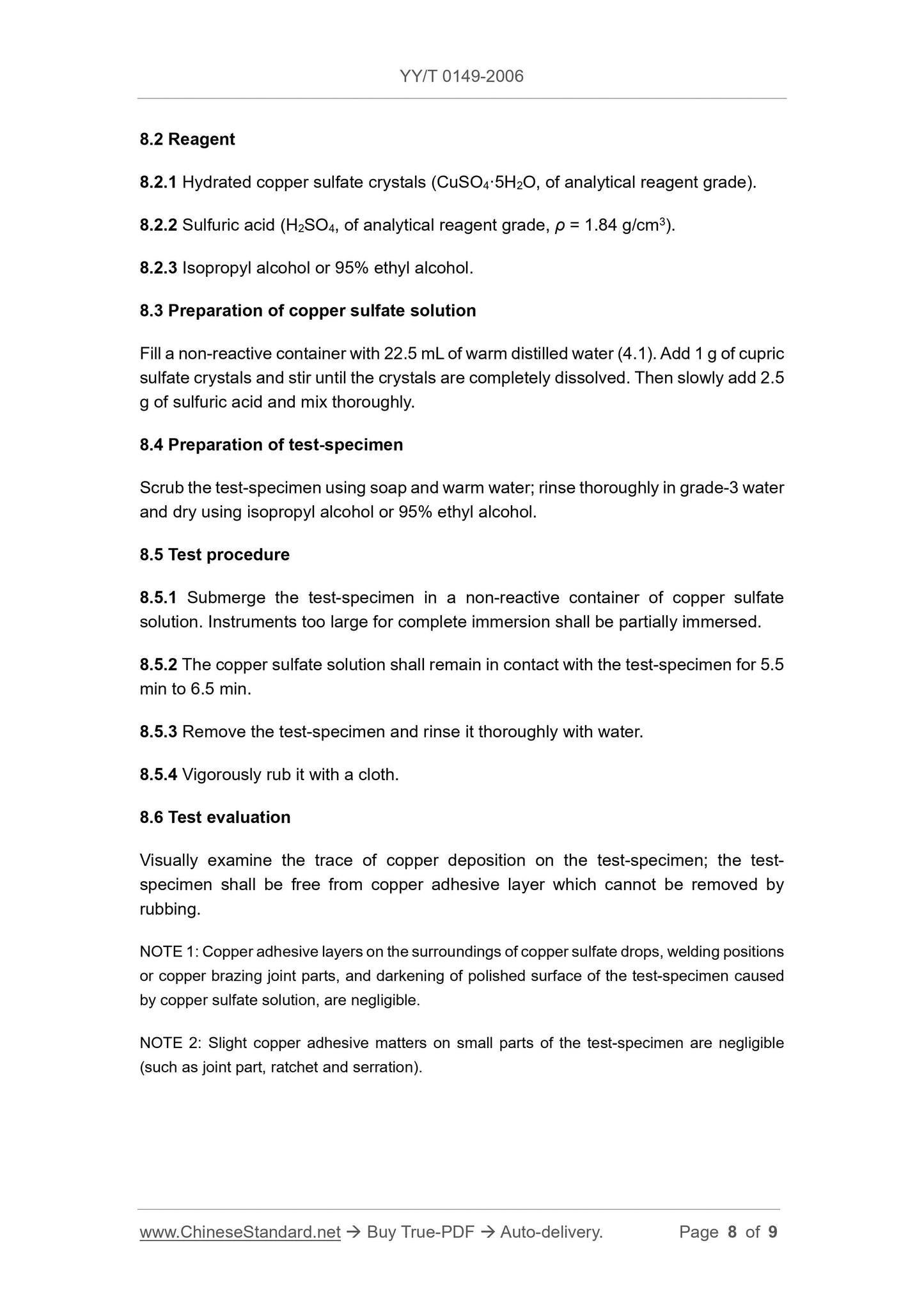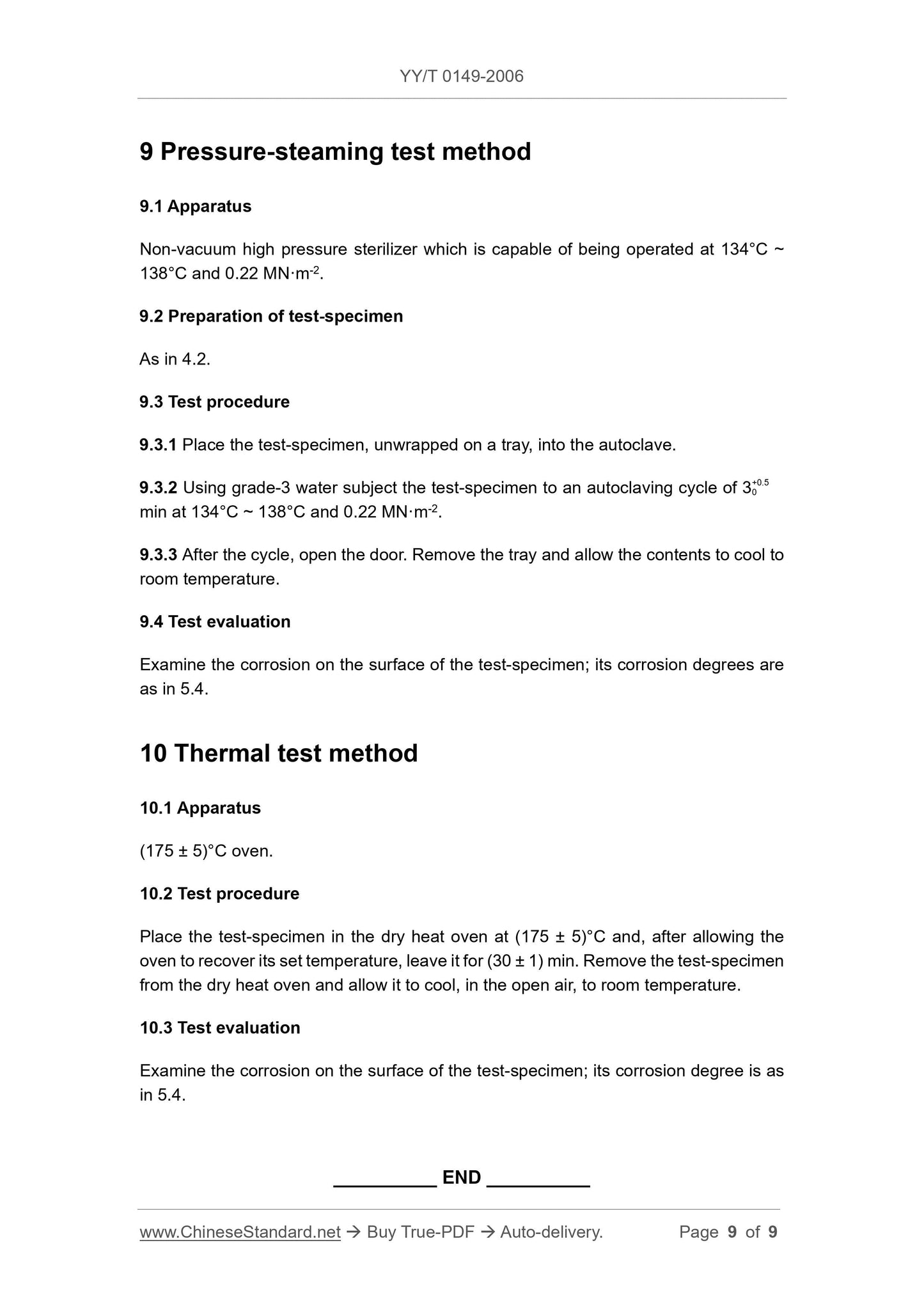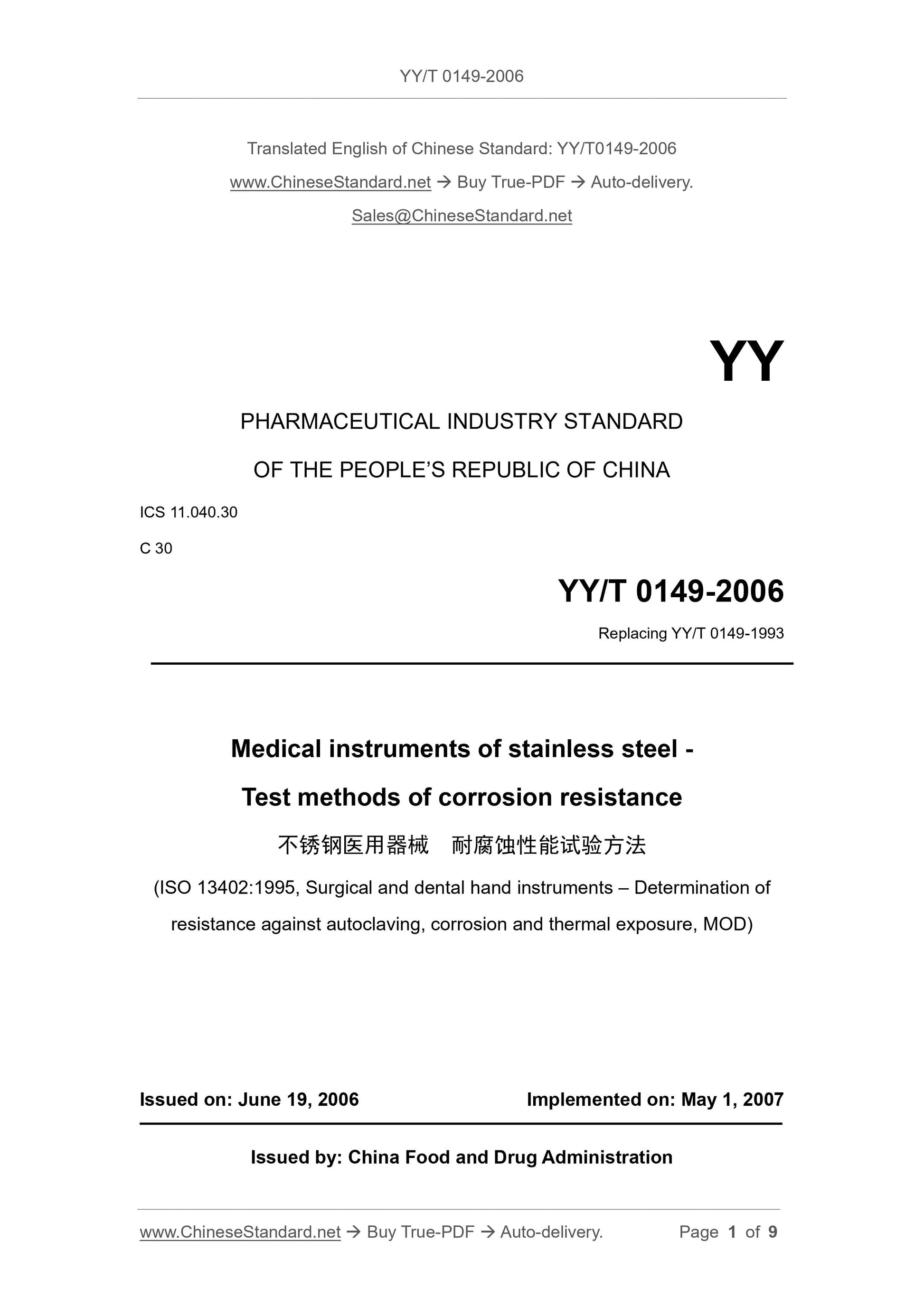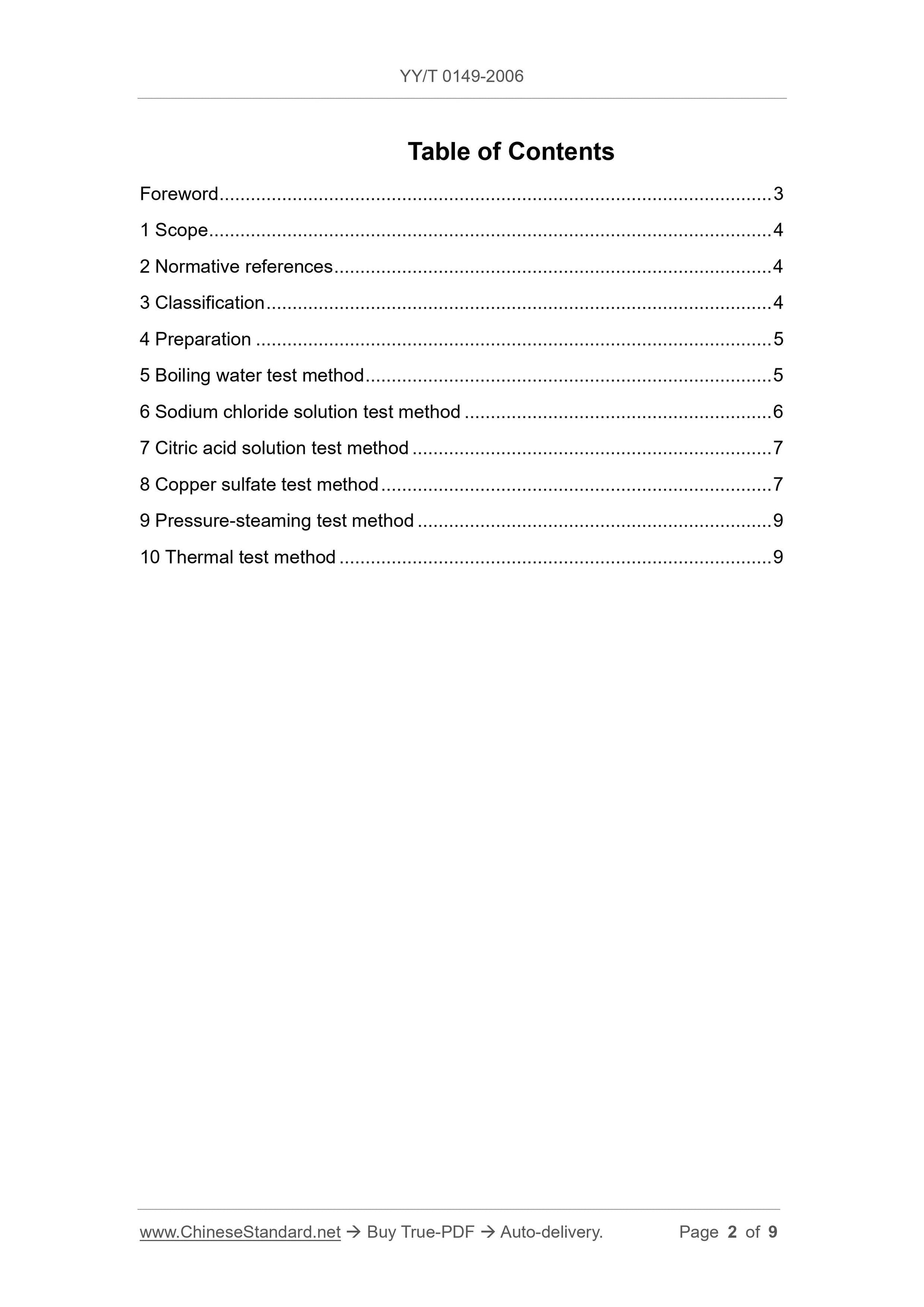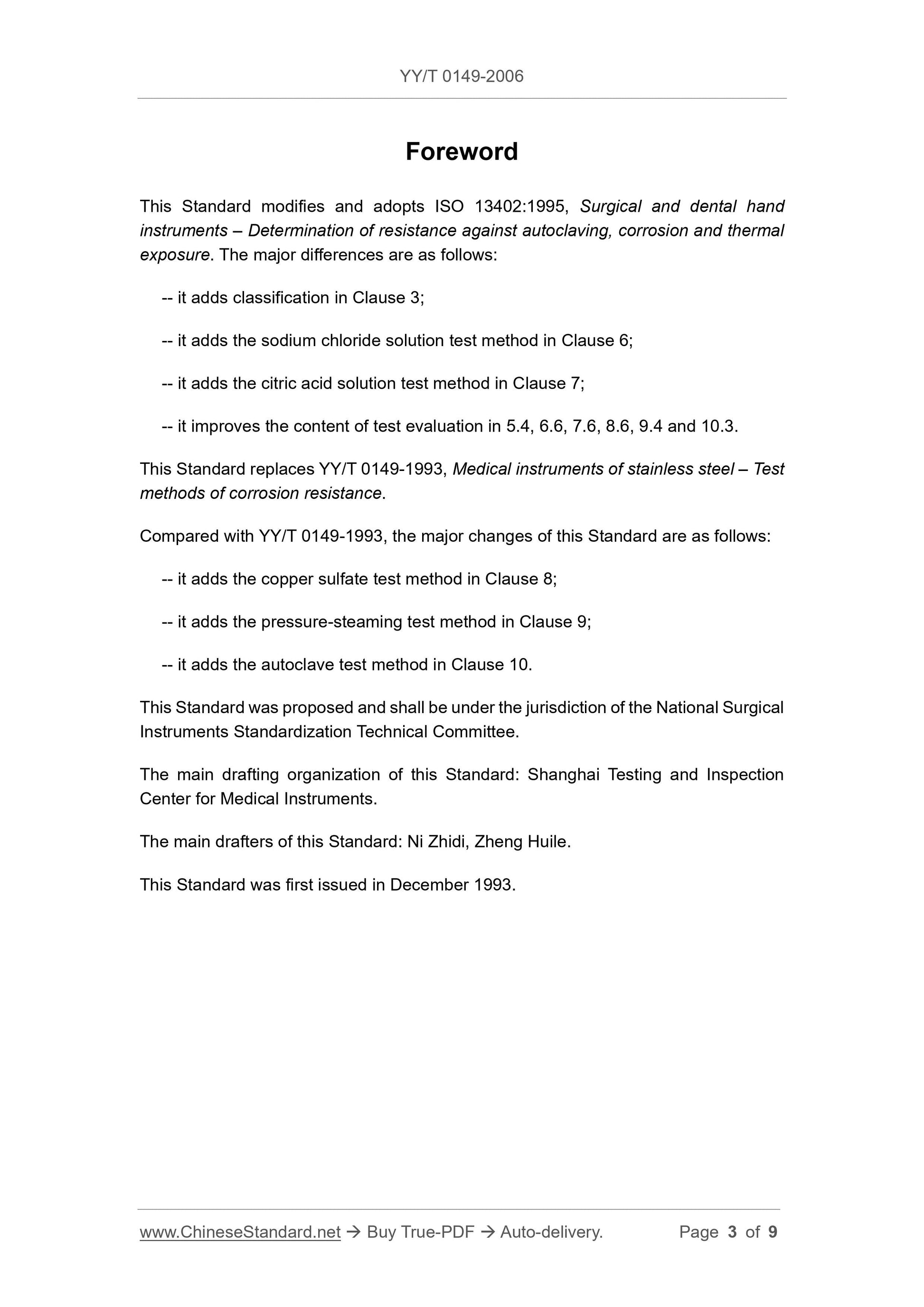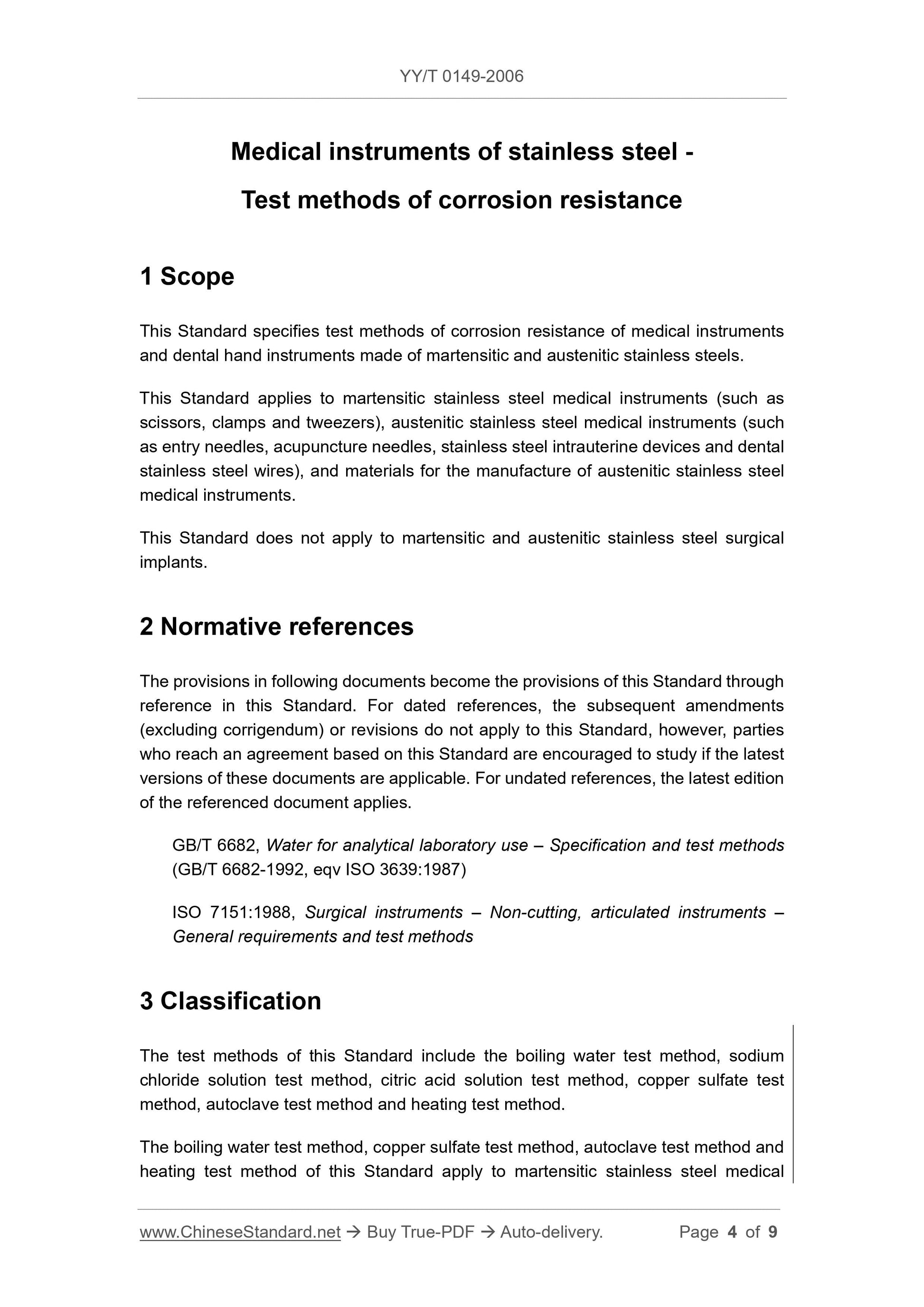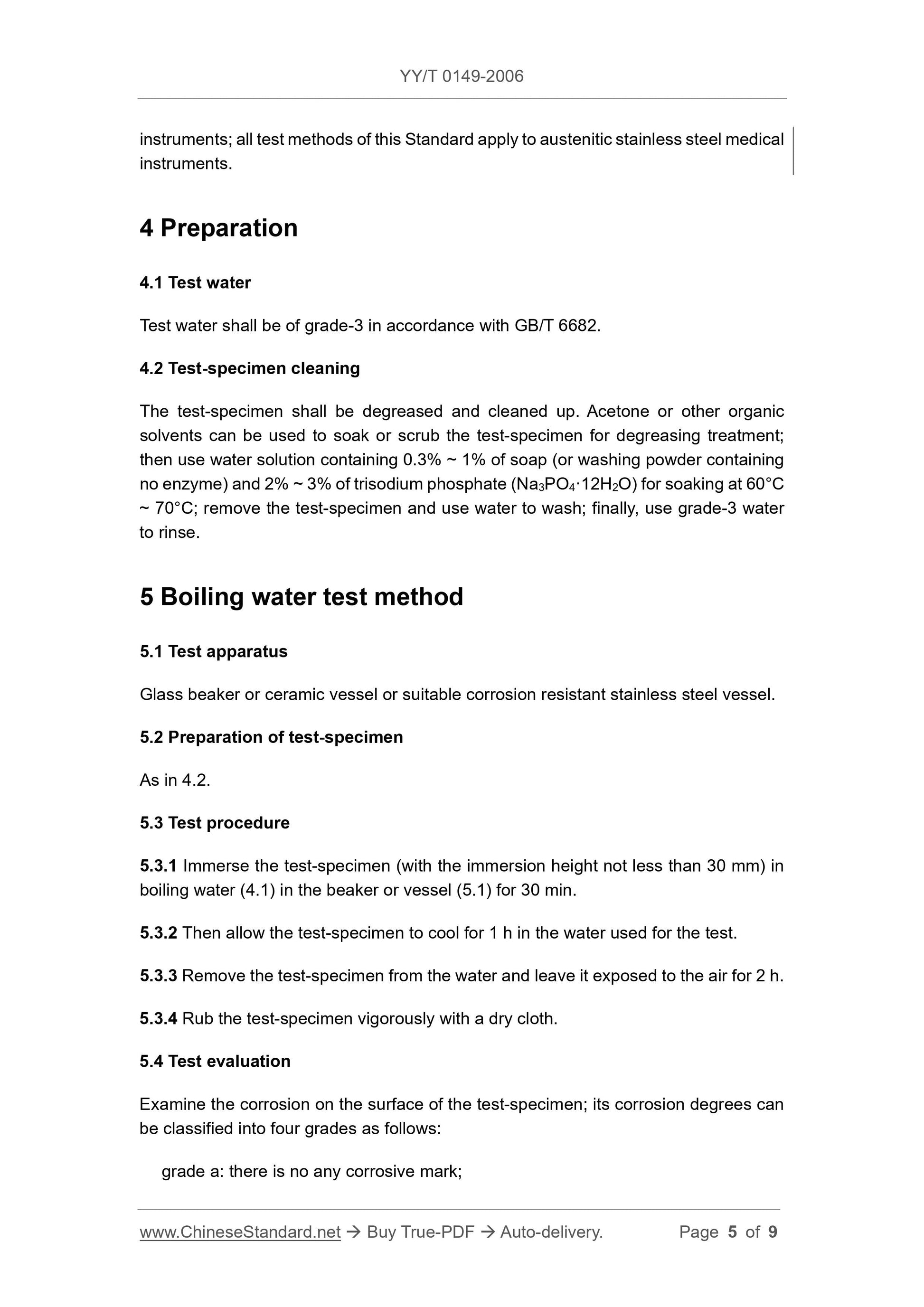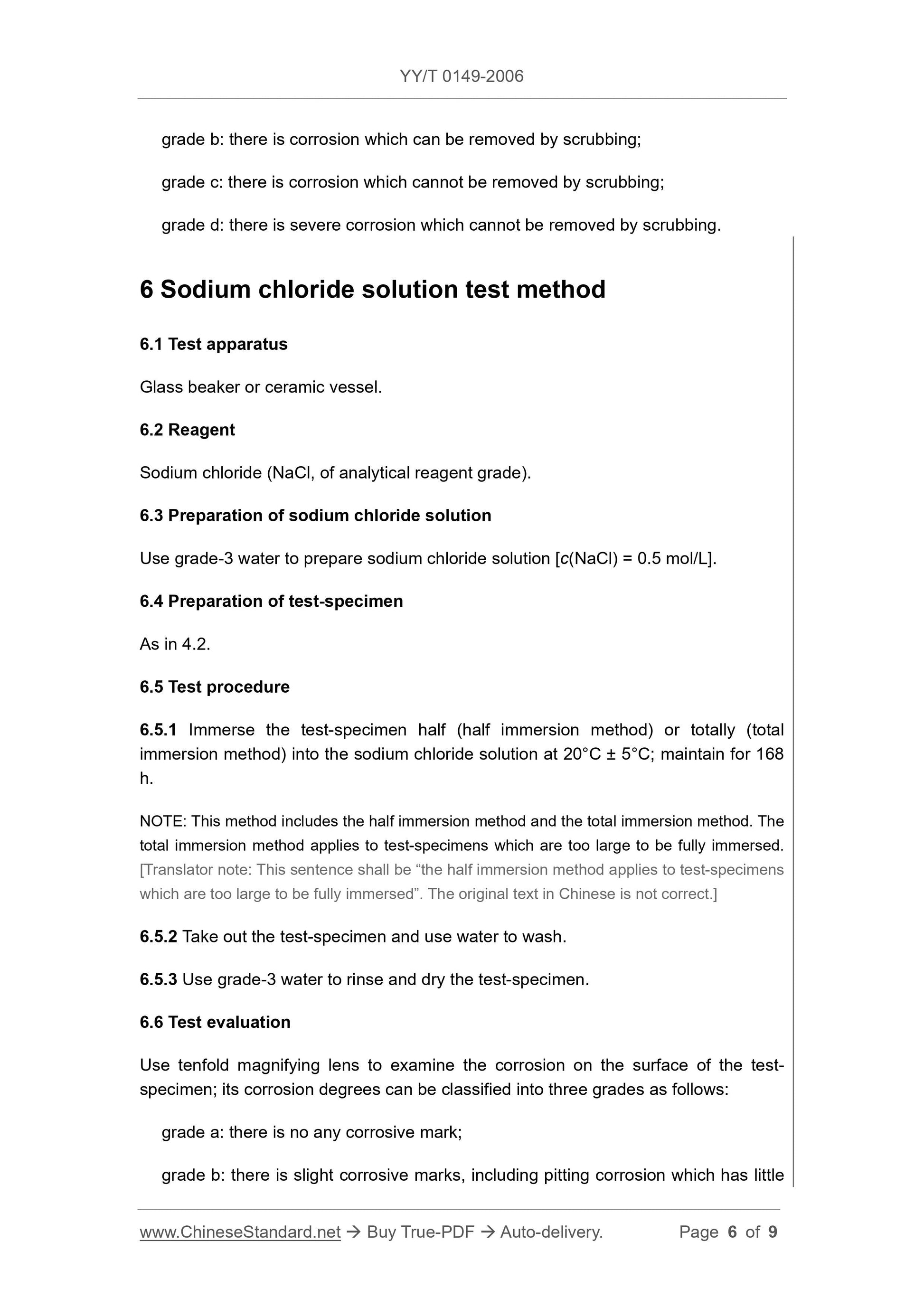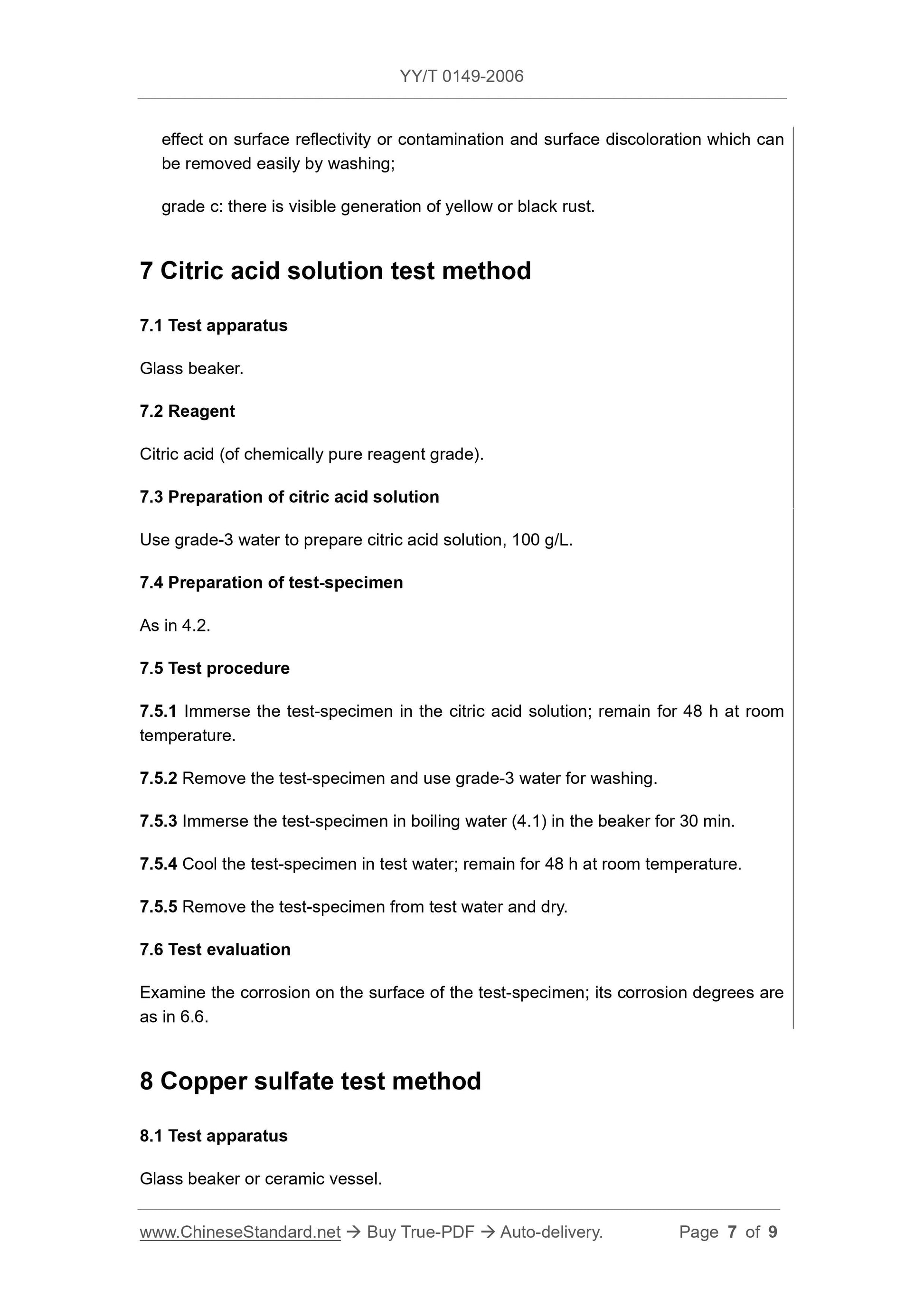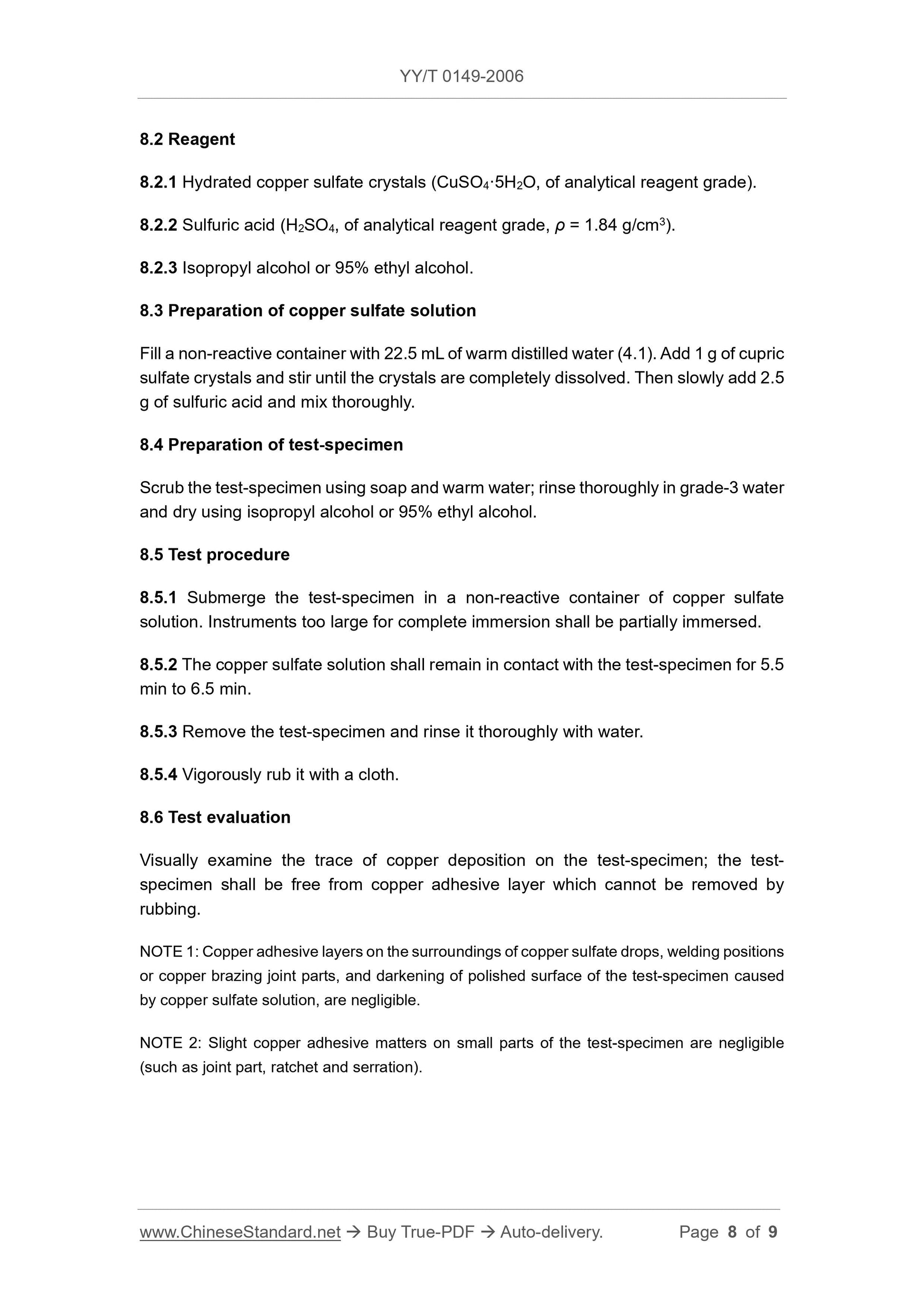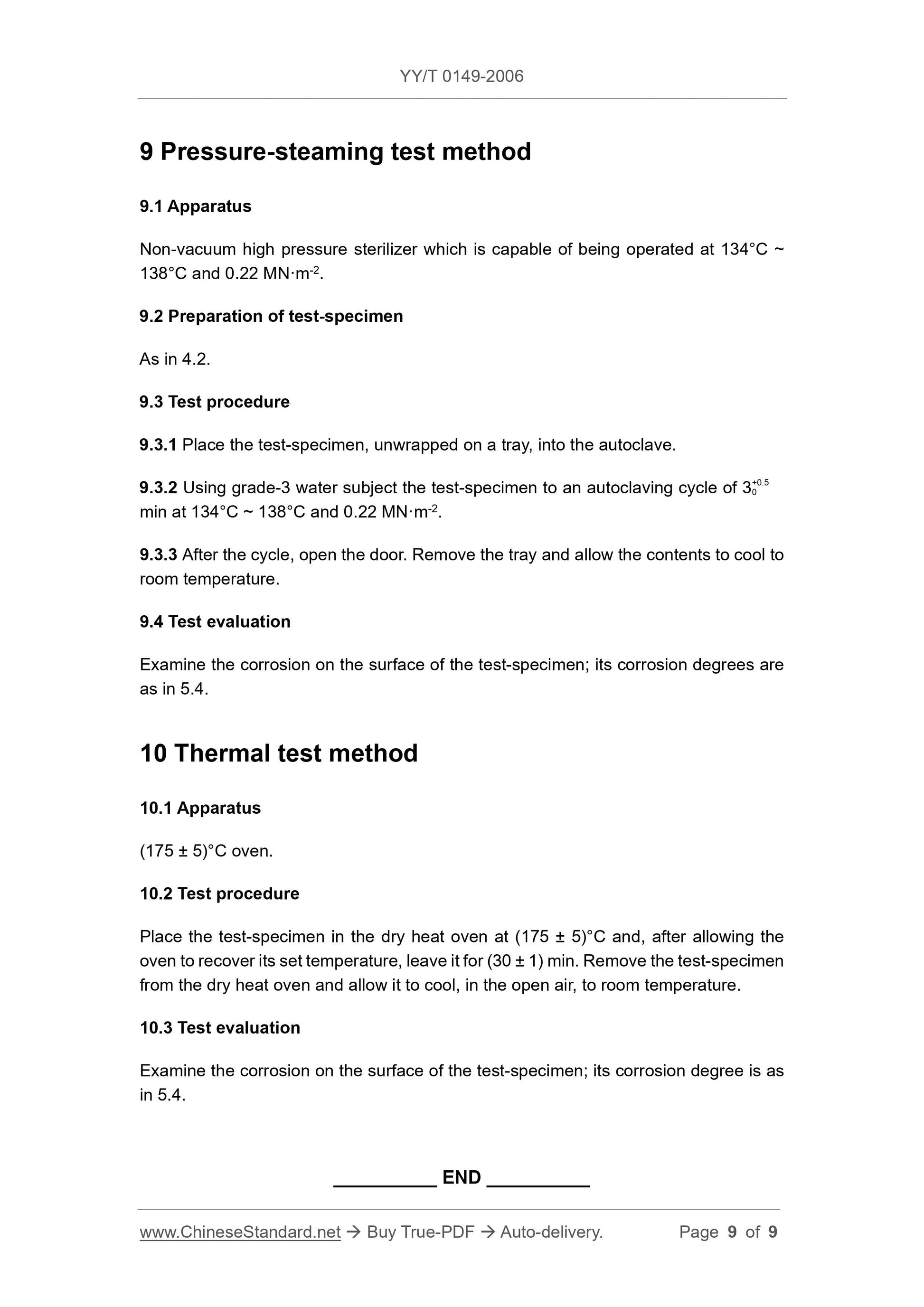1
/
su
9
PayPal, credit cards. Download editable-PDF & invoice in 1 second!
YY/T 0149-2006 English PDF (YYT0149-2006)
YY/T 0149-2006 English PDF (YYT0149-2006)
Prezzo di listino
$80.00 USD
Prezzo di listino
Prezzo scontato
$80.00 USD
Prezzo unitario
/
per
Spese di spedizione calcolate al check-out.
Impossibile caricare la disponibilità di ritiro
Delivery: 3 seconds. Download true-PDF + Invoice.
Get QUOTATION in 1-minute: Click YY/T 0149-2006
Historical versions: YY/T 0149-2006
Preview True-PDF (Reload/Scroll if blank)
YY/T 0149-2006: Medical instruments of stainless steel. Test methods of corrosion resistance
YY/T 0149-2006
YY
PHARMACEUTICAL INDUSTRY STANDARD
OF THE PEOPLE’S REPUBLIC OF CHINA
ICS 11.040.30
C 30
Replacing YY/T 0149-1993
Medical instruments of stainless steel -
Test methods of corrosion resistance
(ISO 13402.1995, Surgical and dental hand instruments – Determination of
resistance against autoclaving, corrosion and thermal exposure, MOD)
ISSUED ON. JUNE 19, 2006
IMPLEMENTED ON. MAY 1, 2007
Issued by. China Food and Drug Administration
Table of Contents
Foreword ... 3
1 Scope ... 4
2 Normative references ... 4
3 Classification ... 4
4 Preparation ... 5
5 Boiling water test method ... 5
6 Sodium chloride solution test method ... 6
7 Citric acid solution test method ... 7
8 Copper sulfate test method ... 7
9 Pressure-steaming test method ... 9
10 Thermal test method ... 9
Medical instruments of stainless steel -
Test methods of corrosion resistance
1 Scope
This Standard specifies test methods of corrosion resistance of medical instruments
and dental hand instruments made of martensitic and austenitic stainless steels.
This Standard applies to martensitic stainless steel medical instruments (such as
scissors, clamps and tweezers), austenitic stainless steel medical instruments (such
as entry needles, acupuncture needles, stainless steel intrauterine devices and dental
stainless steel wires), and materials for the manufacture of austenitic stainless steel
medical instruments.
This Standard does not apply to martensitic and austenitic stainless steel surgical
implants.
2 Normative references
The provisions in following documents become the provisions of this Standard through
reference in this Standard. For dated references, the subsequent amendments
(excluding corrigendum) or revisions do not apply to this Standard, however, parties
who reach an agreement based on this Standard are encouraged to study if the latest
versions of these documents are applicable. For undated references, the latest edition
of the referenced document applies.
GB/T 6682, Water for analytical laboratory use – Specification and test methods
(GB/T 6682-1992, eqv ISO 3639.1987)
ISO 7151.1988, Surgical instruments – Non-cutting, articulated instruments –
General requirements and test methods
3 Classification
The test methods of this Standard include the boiling water test method, sodium
chloride solution test method, citric acid solution test method, copper sulfate test
method, autoclave test method and heating test method.
The boiling water test method, copper sulfate test method, autoclave test method and
heating test method of this Standard apply to martensitic stainless steel medical
grade b. there is corrosion which can be removed by scrubbing;
grade c. there is corrosion which cannot be removed by scrubbing;
grade d. there is severe corrosion which cannot be removed by scrubbing.
6 Sodium chloride solution test method
6.1 Test apparatus
Glass beaker or ceramic vessel.
6.2 Reagent
Sodium chloride (NaCl, of analytical reagent grade).
6.3 Preparation of sodium chloride solution
Use grade-3 water to prepare sodium chloride solution [c(NaCl) = 0.5 mol/L].
6.4 Preparation of test-specimen
As in 4.2.
6.5 Test procedure
6.5.1 Immerse the test-specimen half (half immersion method) or totally (total
immersion method) into the sodium chloride solution at 20°C ± 5°C; maintain for 168
h.
NOTE. This method includes the half immersion method and the total immersion method. The
total immersion method applies to test-specimens which are too large to be fully immersed.
[Translator note. This sentence shall be “the half immersion method applies to test-specimens
which are too large to be fully immersed”. The original text in Chinese is not correct.]
6.5.2 Take out the test-specimen and use water to wash.
6.5.3 Use grade-3 water to rinse and dry the test-specimen.
6.6 Test evaluation
Use tenfold magnifying lens to examine the corrosion on the surface of the test-
specimen; its corrosion degrees can be classified into three grades as follows.
grade a. there is no any corrosive mark;
grade b. there is slight corrosive marks, including pitting corrosion which has little
effect on surface reflectivity or contamination and surface discoloration which can
be removed easily by washing;
grade c. there is visible generation of yellow or black rust.
7 Citric acid solution test method
7.1 Test apparatus
Glass beaker.
7.2 Reagent
Citric acid (of chemically pure reagent grade).
7.3 Preparation of citric acid solution
Use grade-3 water to prepare citric acid solution, 100 g/L.
7.4 Preparation of test-specimen
As in 4.2.
7.5 Test procedure
7.5.1 Immerse the test-specimen in the citric acid solution; remain for 48 h at room
temperature.
7.5.2 Remove the test-specimen and use grade-3 water for washing.
7.5.3 Immerse the test-specimen in boiling water (4.1) in the beaker for 30 min.
7.5.4 Cool the test-specimen in test water; remain for 48 h at room temperature.
7.5.5 Remove the test-specimen from test water and dry.
7.6 Test evaluation
Examine the corrosion on the surface of the test-specimen; its corrosion degrees are
as in 6.6.
8 Copper sulfate test method
8.1 Test apparatus
Glass beaker or ceramic vessel.
Get QUOTATION in 1-minute: Click YY/T 0149-2006
Historical versions: YY/T 0149-2006
Preview True-PDF (Reload/Scroll if blank)
YY/T 0149-2006: Medical instruments of stainless steel. Test methods of corrosion resistance
YY/T 0149-2006
YY
PHARMACEUTICAL INDUSTRY STANDARD
OF THE PEOPLE’S REPUBLIC OF CHINA
ICS 11.040.30
C 30
Replacing YY/T 0149-1993
Medical instruments of stainless steel -
Test methods of corrosion resistance
(ISO 13402.1995, Surgical and dental hand instruments – Determination of
resistance against autoclaving, corrosion and thermal exposure, MOD)
ISSUED ON. JUNE 19, 2006
IMPLEMENTED ON. MAY 1, 2007
Issued by. China Food and Drug Administration
Table of Contents
Foreword ... 3
1 Scope ... 4
2 Normative references ... 4
3 Classification ... 4
4 Preparation ... 5
5 Boiling water test method ... 5
6 Sodium chloride solution test method ... 6
7 Citric acid solution test method ... 7
8 Copper sulfate test method ... 7
9 Pressure-steaming test method ... 9
10 Thermal test method ... 9
Medical instruments of stainless steel -
Test methods of corrosion resistance
1 Scope
This Standard specifies test methods of corrosion resistance of medical instruments
and dental hand instruments made of martensitic and austenitic stainless steels.
This Standard applies to martensitic stainless steel medical instruments (such as
scissors, clamps and tweezers), austenitic stainless steel medical instruments (such
as entry needles, acupuncture needles, stainless steel intrauterine devices and dental
stainless steel wires), and materials for the manufacture of austenitic stainless steel
medical instruments.
This Standard does not apply to martensitic and austenitic stainless steel surgical
implants.
2 Normative references
The provisions in following documents become the provisions of this Standard through
reference in this Standard. For dated references, the subsequent amendments
(excluding corrigendum) or revisions do not apply to this Standard, however, parties
who reach an agreement based on this Standard are encouraged to study if the latest
versions of these documents are applicable. For undated references, the latest edition
of the referenced document applies.
GB/T 6682, Water for analytical laboratory use – Specification and test methods
(GB/T 6682-1992, eqv ISO 3639.1987)
ISO 7151.1988, Surgical instruments – Non-cutting, articulated instruments –
General requirements and test methods
3 Classification
The test methods of this Standard include the boiling water test method, sodium
chloride solution test method, citric acid solution test method, copper sulfate test
method, autoclave test method and heating test method.
The boiling water test method, copper sulfate test method, autoclave test method and
heating test method of this Standard apply to martensitic stainless steel medical
grade b. there is corrosion which can be removed by scrubbing;
grade c. there is corrosion which cannot be removed by scrubbing;
grade d. there is severe corrosion which cannot be removed by scrubbing.
6 Sodium chloride solution test method
6.1 Test apparatus
Glass beaker or ceramic vessel.
6.2 Reagent
Sodium chloride (NaCl, of analytical reagent grade).
6.3 Preparation of sodium chloride solution
Use grade-3 water to prepare sodium chloride solution [c(NaCl) = 0.5 mol/L].
6.4 Preparation of test-specimen
As in 4.2.
6.5 Test procedure
6.5.1 Immerse the test-specimen half (half immersion method) or totally (total
immersion method) into the sodium chloride solution at 20°C ± 5°C; maintain for 168
h.
NOTE. This method includes the half immersion method and the total immersion method. The
total immersion method applies to test-specimens which are too large to be fully immersed.
[Translator note. This sentence shall be “the half immersion method applies to test-specimens
which are too large to be fully immersed”. The original text in Chinese is not correct.]
6.5.2 Take out the test-specimen and use water to wash.
6.5.3 Use grade-3 water to rinse and dry the test-specimen.
6.6 Test evaluation
Use tenfold magnifying lens to examine the corrosion on the surface of the test-
specimen; its corrosion degrees can be classified into three grades as follows.
grade a. there is no any corrosive mark;
grade b. there is slight corrosive marks, including pitting corrosion which has little
effect on surface reflectivity or contamination and surface discoloration which can
be removed easily by washing;
grade c. there is visible generation of yellow or black rust.
7 Citric acid solution test method
7.1 Test apparatus
Glass beaker.
7.2 Reagent
Citric acid (of chemically pure reagent grade).
7.3 Preparation of citric acid solution
Use grade-3 water to prepare citric acid solution, 100 g/L.
7.4 Preparation of test-specimen
As in 4.2.
7.5 Test procedure
7.5.1 Immerse the test-specimen in the citric acid solution; remain for 48 h at room
temperature.
7.5.2 Remove the test-specimen and use grade-3 water for washing.
7.5.3 Immerse the test-specimen in boiling water (4.1) in the beaker for 30 min.
7.5.4 Cool the test-specimen in test water; remain for 48 h at room temperature.
7.5.5 Remove the test-specimen from test water and dry.
7.6 Test evaluation
Examine the corrosion on the surface of the test-specimen; its corrosion degrees are
as in 6.6.
8 Copper sulfate test method
8.1 Test apparatus
Glass beaker or ceramic vessel.
Share
